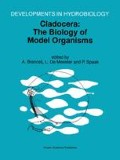Abstract
Information on mating behaviour in Anomopoda is available for very few species only, though mate location and recognition certainly play an important role in maintaining reproductive isolation between species. Ephippial females and males of Moina brachiata were observed in a drop of water under a microscope for 10–20 minutes. Different combinations of specimens were used, but copulation was only observed when two males and two ephippial females were placed together. Males were very active, and often tried to grasp a female, whereas females usually made attempts to escape during the entire period of mating. Three phases were recognized: capture, positioning and copulation. The male captured the female from the dorsal side, then moved to the ventral side and took a position with its length axis being perpendicular to that of the female, forming a sort of cross. Thereafter the pair started rotating around the length axis of the female, while the male pushed the postabdomen into the female’s brood pouch. Copulation lasted from 16 to 25 seconds. When different kinds of females were used, males showed preference for ephippial females with an empty ephippium and enlarged ovaries. Our results indicate that not only visual and tactile cues may be important in identifying species identity and receptivity of the female, but also chemical signals.
Access this chapter
Tax calculation will be finalised at checkout
Purchases are for personal use only
Preview
Unable to display preview. Download preview PDF.
References
Brauer, F., 1872. Beiträge zur Kenntniss der Phyllopoden. Sber. kais. Akad. Wiss., Math.-naturw. Kl., Abt. I, 65: 279–291.
Carmona, M. J. & T. W. Snell, 1995. Glycoproteins in daphnids: Potential signals for mating? Arch. Hydrobiol. 134: 273–279.
Cohen, A. C. & J. G. Morin, 1990. Patterns of reproduction in ostracodes: a review. J. crust. Biol. 10: 184–211.
Crease, T. J. & P. D. N. Hebert, 1983. A test for the production of sexual pheromones by Daphnia magna (Crustacea: Cladocera). Freshwat. Biol. 13: 491–496.
Dodson, S. I. & D. G. Frey, 1991. Cladocera and other Branchiopoda. In Thorp, J. H. & A. P. Covich (eds), Ecology and Classification of North American Freshwater Invertebrates. Academic Press, New York: 723–786.
Glatzel, T. & H. K. Schminke, 1996. Mating behaviour of the groundwater copepod Parastenocaris phyllura Kiefer, 1938 (Copepoda: Harpacicoida). Contributions to Zoology 66: 103–108.
Gordo, T., L. M. Lubián & J. P. Canavate, 1994. Influence of temperature on growth, reproduction and longevity oîMoina salina Daday, 1888 (Cladocera, Moinidae). J. Plankton Res. 16: 1513–1523.
Goulden, C. E. 1966. Co-occurrence of moinid Cladocera and possible isolating mechanisms. Verh. int. Ver. Limnol. 16: 1669–1672.
Goulden, C. E., 1968. The systematics and evolution of the Moinidae. Trans, am. phil. Soc. N.S. 58: 1–101.
Gravier, C. & P. Mathias, 1930. Sur la reproduction d’un Crustacé Phyllopode du groupe des Conchostracés (Cyzicus cycladoides (Joly)). CR. acad. Sci. Paris 191: 183–185.
Grosvenor, G. H. & G. Smith, 1913. The life-cycle of Moina rectirostris. Quart. J. microsc. Sci. 58: 511–522.
Jurine, L., 1820. Histoire des Monocles, qui se trouvent aux environs de Genève. J. J. Paschoud, Paris, 260 pp.
Larsson, P. & S. Dodson, 1993. Chemical communication in plank-tonic animals. Arch. Hydrobiol. 129: 129–155.
Martin, J. W., B. E. Felgenhauer & L. G. Abele, 1986. Redescription of the clam shrimp Lynceus gracilicornis (Packard) (Branchiopoda, Conchostraca, Lynceidae) from Florida, with notes on its biology. Zool. Scr. 15: 221–232.
Mathias, P., 1937. Biologie des Crustaces Phyllopodes. Hermann & Cie, Paris, 107 pp.
Müller, O. F., 1785. Entomostraca seu Insecta Testacea, quae in aquis Daniae et Norvegiae reperit, descripsit et iconibus illustravit. Lipsiae et Havniae, 135 pp.
Scharfenberg, U., 1911. Studien und Experimente über die Eibildung und den Generationszyklus von Daphnia magna. Int. Revue ges. Hydrobiol. Hydrogr. 3, Biologisches Supplement, 42 pp.
Scourfield, D. J., 1905. Die sogenannten Riechstäbchen bei den Cladoceren. Forschungsber. biol. Stat. Plön 12: 340–353.
Shan, R. K., 1969. Life cycle of a chydorid cladoceran, Pleuroxus denticulatus Birge. Hydrobiologia 34: 295–302.
Smirnov, N. N., 1971. Chydoridae fauny mira. Fauna SSSR. Nov. Ser. No. 101. Rakoobraznyye. Volume 1. vyp. 2, 531 pp.
Snell, T. W. & P. D. Morris, 1993. Sexual communication in cope-pods and rotifers. Hydrobiologia 255/256: 109–116.
Snell, T. W. & M. J. Carmona, 1994. Surface glycoproteins in copepods: potential signals for mate recognition. Hydrobiologia 292/293: 255–264.
Weismann, A., 1880. Beiträge zur Naturgeschichte der Daphnoiden. VI. Samen und Begattung der Daphnoiden. Z. wiss. Zool. 33: 55–256.
Author information
Authors and Affiliations
Editor information
Rights and permissions
Copyright information
© 1997 Springer Science+Business Media Dordrecht
About this paper
Cite this paper
Forró, L. (1997). Mating behaviour in Moina brachiata (Jurine, 1820) (Crustacea, Anomopoda). In: Brancelj, A., De Meester, L., Spaak, P. (eds) Cladocera: the Biology of Model Organisms. Developments in Hydrobiology, vol 126. Springer, Dordrecht. https://doi.org/10.1007/978-94-011-4964-8_17
Download citation
DOI: https://doi.org/10.1007/978-94-011-4964-8_17
Publisher Name: Springer, Dordrecht
Print ISBN: 978-94-010-6084-4
Online ISBN: 978-94-011-4964-8
eBook Packages: Springer Book Archive

